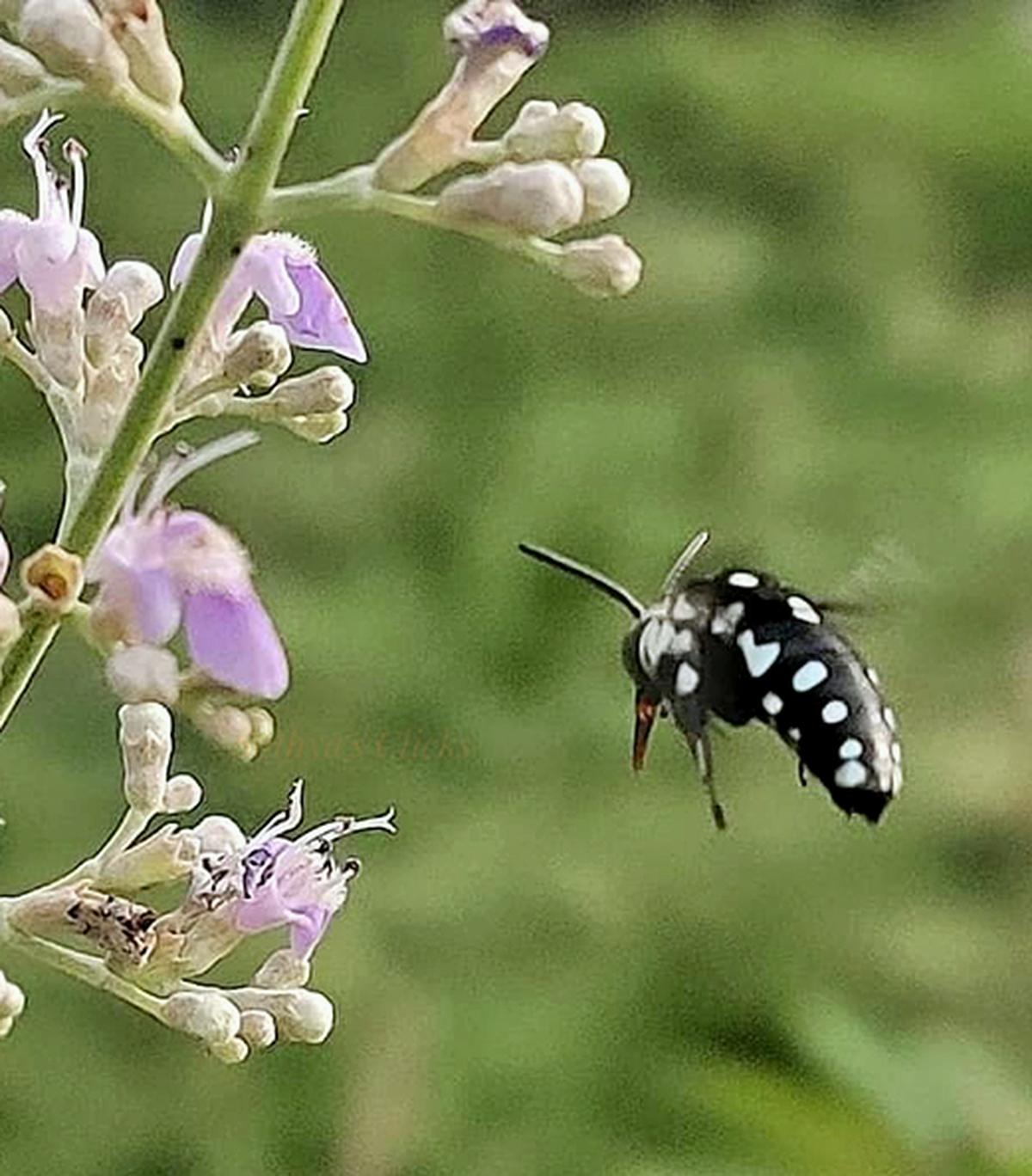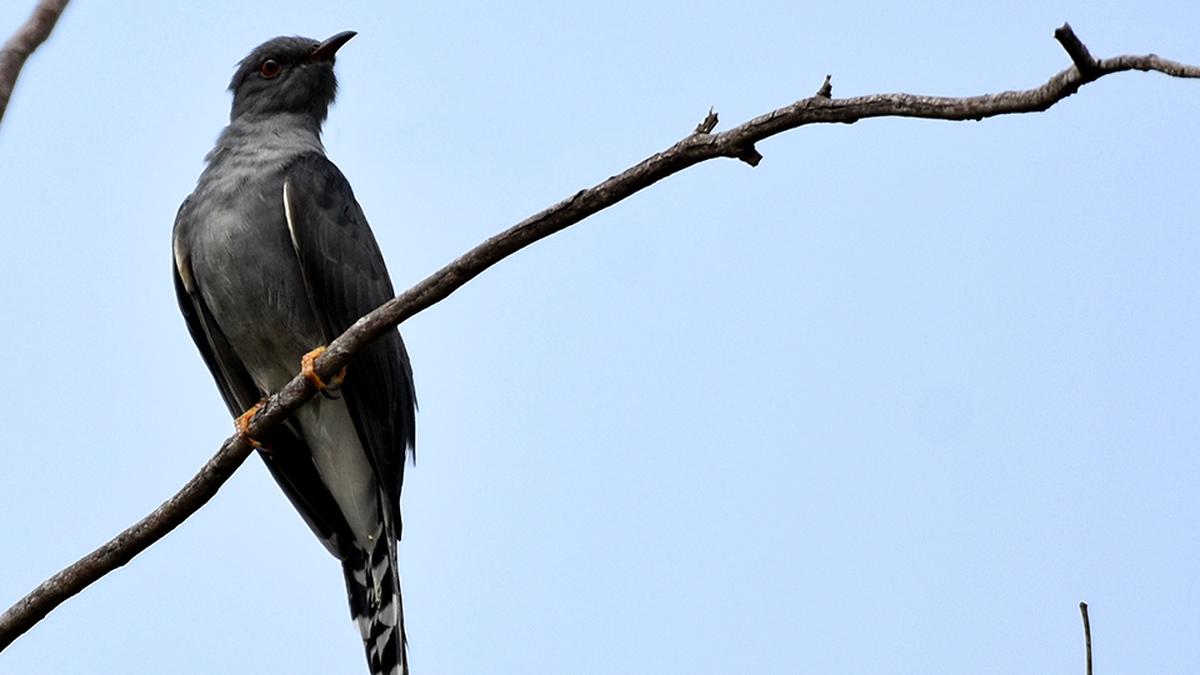A grey-bellied cuckoo; and (below) a cloak-and-dagger bee at the Adyar river bund in Mugalivakkam.
| Photo Credit: Sathyakumar Shanmugasundaram

If birding hotspots were to be assigned mascots, the Adyar river bund at Mugaliwakkaam, near the military quarters should have the bittern as its mascot. Bittern of any stripe associated with Chennai can fill that role. Sathyakumar Shanmugasundaram, birder and a resident of Mugalivakkam, notes all bitterns that occur in these parts are sighted at this spot — the black, yellow and cinnamon bitterns. These birds being inveterate skulkers (the black and cinnamon bitterns have skulking down to a fine art) one can have fleeting glimpses of them in flight before they melt back into the reeds, elaborates Sathyakumar.
Sathyakumar paints a picture of the place: this patch is deliciously sequestered. By the side of the bund where birders flock to see feathers, the military quarters is paired with a small patch of reserve forest. Along the opposite bund, on the other side of the river, there is a stretch of reserve forest behind which lies the airport.
In terms of surprise visits, one worth wiring home about, members of the cuculidae family (put in a plain term, cuckoos) give the members of the botaurinae family (put in another plain term, bitterns) a stiff competition.
“I have seen the grey-bellied cuckoo as well as and the regular hawk cuckoos, which I have largely heard No sightting of Eurasian cuckoo,” says Sathyakumar.
Sathyakumar’s list includes the Indian pitta (“one can surely hear its call”). Sathyakumar remarks that birders have seen the Indian nightjar on the bund — he himself has not as he does not hit the bund at night.
Safety is not an issue on the bund as it is well-hoofed as a walking and to some extent, a jogging track. The bund faces the rear-side of IAS Colony and IPS Colony. Residents of these enclaves hit the bund for walking. The side of the bund bears markings denoting the kilometres — 0.5, 1, 1.5 all the way to 3 kilometre in increments of 0.5 kilometre.
Spotted eagle spotted at Perumbakkam
A spotted eagle sighted at Perumbakkam wetland on November 2, 2024
| Photo Credit:
PRINCE FREDERICK
A greater spotted spotted eagle “owns” an electricity pole at the Perumbakkam wetland on November 2, 2024. The greater spotted eagle is a winter visitor in these parts. In the days to come, the others “poles” will be offered in auction to the winter-visiting raptors, and they will take their rightful places. The osprey is among the raptors that is known to be at ease perched on a power pole. The marsh harrier pitches tent in the Perumbakkam wetland and is not much of a patron of these electricity poles.
COMFORT ZONE
Spot-billed pelicans perched on the pylons and wires at the Pallikaranai marsh, on October 27, 2024. These pelicans could be seen flying from the NIOT camps on settling on this pylon in the crepuscular hour
| Photo Credit:
PRINCE FREDERICK
Spot-billed pelicans perched on trees at NIOT campus in Pallikaranai, on October 27, 2024
| Photo Credit:
PRINCE FREDERICK
There is obviously no sub-species called “NIOT pelicans” under Pelecanus philippensis (the spot-billed pelican). But NIOT pelicans as a conservation category does exist in the minds of those cheerleading for this squat bird, which began to have Chennai addresses on its calling card. a decade and a half ago.
The conducive and safe environment provided by the NIOT campus has contributed in no small measure to the increase in the spot-billed pelican population in Chennai. In terms of conservation, it is a huge success story one displaying no signs of jadedness despite a million tellings. Extraneous factors are brought to bear on the value of a home. Its value is enhanced or diminished by the character of what lies immediately outside its gates. The neighbours, the immediate physical environment and the commerce that allows people to access essentials with ease. The spot-billed pelicans live on the campus, multiplying their numbers by turning the treetops into maternity wards. As the Pallikaranai marsh is cheek by jowl with the campus, the NIOT pelican parents do not have to cast around for a preschool to prepare the young for the rigours of adult life. The pylons at the Pallikaranai marsh are an equivalent of a sitout. In the crepuscular hour, the pylons are wrapped up in feathers — with spot-billed pelicans taking their place on the iron bars as well as the power wires.
Published – November 04, 2024 10:59 pm IST
